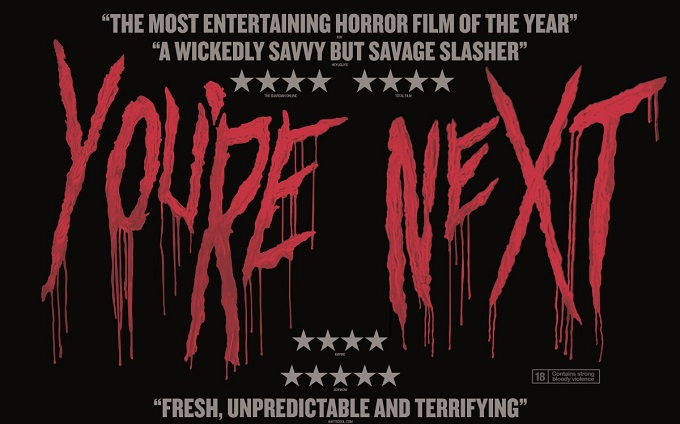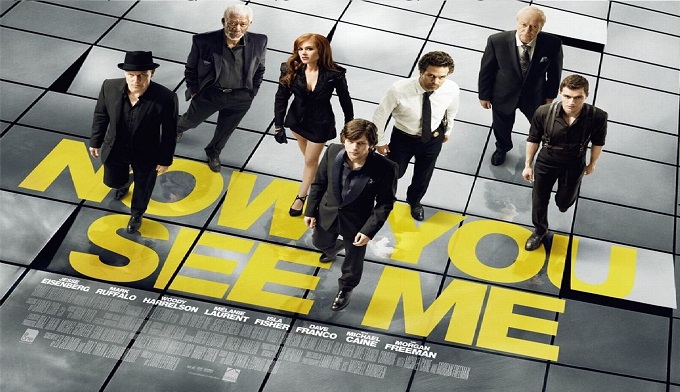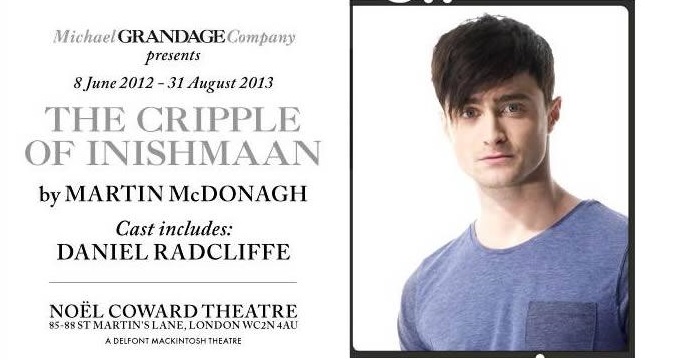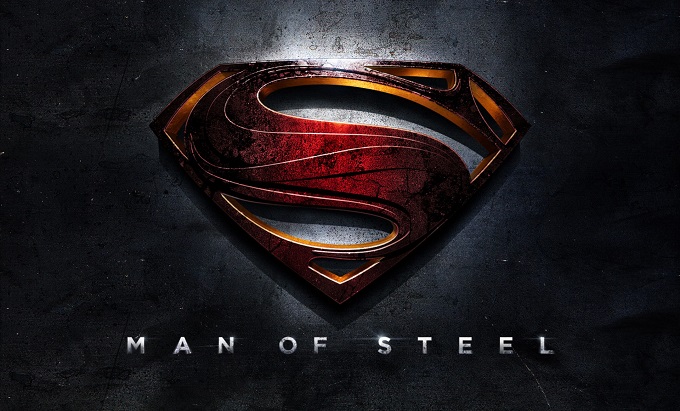You’re Next Review

The Plot:
A group of seemingly random attackers gets more than they bargained for when they terrorise a family reunion dinner party. As son Crispian’s new girlfriend Erin turns into the family’s only hope to survive.
The Good:
From the opening scene of Adam Wingard’s latest horror, it’s clear that any slasher fan will be happy for the next ninety minutes. With one of the catchiest songs ever accompanying an entertaining and genuinely funny script You’re Next doesn’t fail to keep you interested. Wingard’s hauntingly simple lingering shocks as well as superb performances from the cast makes this a treat which will have you laughing out loud right before you gasp in horror and shock. Whilst at first seeming like a quirky dysfunctional family comedy, Wingard easily builds the tension up until finally releasing it all in a fantastically disorientated dinner scene.
From then on, You’re Next becomes a fast paced thriller as the Davison family fight to survive the night with the help of Erin (Sharni Vinson – Home and Away‘s Cassie Turner) and her expert knowledge in combat. Whether it’s AJ Bowen’s great comic timing during the dialogue between Crispian and his family, or the surprisingly simple scary masks of the attackers, You’re next offers plenty to entertain you with. However the main treat comes from that of lead actress Sharni Vinson who steals the show as Aussie ass kicker Erin. If this is anything to go by, Vinson is sure to have a stellar career in films and proves herself as a worthy action hero.
The Bad:
Although for the most part, You’re Next stays fresh and entertaining, the final act seems to dampen down a bit. Without spoiling anything, what was a comedy turned thrill fest suddenly switches again, this time into a sort of sick Home Alone. A choice which borders on absurdity.
Another slight let down is the lack of character development in the brisk ninety-five minute run time. Another ten or twenty minutes of some more background story for the Davison family members might have helped the film. And whilst there is humour found from start to finish, often enough it does seem to only pop up here and there out of the blue occasionally.
The Ugly Truth:
The typical slasher genre is given many new depths whilst still hanging onto the stuff that will keep fans happy. With never a dull moment in sight, You’re Next will certainly keep you hooked. You’ll be hard pushed not to want to watch it again and again. If not for the superb action from Vinson or the brilliantly dark humour from Simon Barrett’s screenplay, or even the edge of your seat tension that Wingard brings to the screen, then definitely for the oh so catchy song.
Now You See Me Review

The Plot:
The FBI and Interpol are left baffled when a team of magicians known as the Four Horsemen seemingly rob a bank in France during their Las Vegas magic show and give the money away to their delighted audience. It soon becomes clear that it’s only the start of an elaborate wider plan with mysterious motive, but the Horseman will have to evade a dogged FBI agent and infamous Magical expert if they’re to perform their best trick yet.
The Good:
The initial premise of Now You See Me is vaguely original and conveniently catches hold of the recent popularity surge for magicians. The film ambitiously aims to combine the fun of an Ocean’s 11 heist with the mind-boggling magical drama of The Prestige. It succeeds just enough on both fronts to be consistently watchable and occasionally captivating.
The film’s cast includes Morgan Freeman, Mark Ruffalo, Jesse Eisenberg, Michael Caine, Isla Fisher and Woody Harrelson. It a fortunate collection of new/old talents that explains much of the film’s recent box office success and instantly elevates the material. Morgan Freeman’s gravel voiced gravitas and Mark Ruffalo’s perpetual weariness lend the film some valuable credibility.
Director Louis Leterrier does a competent job of giving the film’s action a glossy style. It’ a polished look borrowed from the heist genre that fits in neatly with the elaborate world of professional illusionists. A perpetually free moving camera in particular helps give the film a sense of momentum and gives at least the impression of clever intricacy.
The Bad:
After a promising start it’s a little disappointing that the film’s a-list ensemble don’t get too many chances to dip beneath the surface. It’s a great cast, but it’s still typecast.
The conscious decision to avoid giving the Four Horseman ‘too much personality’, leaves them a little more two dimensional than mysterious or awe inspiring. Jesse Eisenberg talks very fast, Woody Harrelson is lazily sardonic and Dave Franco… still isn’t James Franco.
It’s a little ironic that a film about deceptive showmanship promises so much but ultimately delivers dissatisfying anti-climaxes. Perhaps part of the problem is that in a world of CGI and special effects trickery, ordinary sleight of hand and implausible plot twists don’t dazzle audiences quite so easily.
The Ugly Truth:
Now You See Me isn’t ever quite as clever or brilliant as its runaway box-office success might imply. Perhaps the film’s best trick has been using a stellar cast to convince eager audiences that it’s “must see” magnificence. However, it remains a watchable addition to the heist genre that will particularly entertain anyone with a fondness for David Copperfield style theatrics.
Bula Quo! Review

The Plot:
Real life rock legends Status Quo find themselves in deep trouble during a tour of the island paradise of Fiji when they witness a murder. Pursued by local mafia thugs, the police and the clueless world’s press, Rick Parfitt and Francis Rossi must dodge danger at every turn to stay alive and keep rockin’ all over the world…
The Good:
Status Quo are one of the most enduringly and surprisingly successful bands on the planet precisely because their instantly recognisable songs and jovial disposition has a unique cheesy charm. After recent documentary Hello Quo!, this new film sees the band’s mischievous frontmen making their most unlikely acting debuts. Though fans have enjoyed/endured decades of countless tours and albums, they’ll certainly never have experienced Status Quo like this before.
Bungling duo Rick and Francis have such an utter lack of acting ability and comic timing that there’s a perverse pleasure in watching them try. Their performances are packed with a steady stream of self-deprecating jokes and a blatant willingness to sacrifice all possible dignity. It’s actually oddly endearing and makes it very abundantly clear that nobody is taking things too seriously.
At times Bula Quo is so unashamedly ridiculous it actually threatens be a work of accidental comedy genius. It’s like watching the increasingly bizarre dream of a devoted Quo fan. A progressively ludicrous plot sees the geriatric rockers uncovering a black market organ harvesting scheme being run by a dastardly local mafia boss (Jon Lovitz). What follows is 90 minutes of painfully absurd action sequences, woefully inadequate acting and frequent breaks for impromptu music videos.
It’s difficult to adequately describe just how strange an experience it is to watch Bula Quo! It’s perhaps the first film in history to feature a ‘high speed’ chase that conveniently involves both kayaks and golf carts. It also features Idiotic thugs attacking our hard rocking heroes with deadly weapons that include… flip flop shoes. It’s really just a lot of tame family friendly shenanigans with occasional moments of genuine hilarity. Whether it’s intentional or by happy accident, some of the film’s delightfully atrocious dialogue is actually memorably magnificent. Such occasional moment of insanity combined with an ashamedly familiar/catchy Status Quo soundtrack keep Bula Quo! tolerable and at times even enjoyable.
The Bad:
Being brutally honest Bula Quo has a production value akin to a Saturday morning children’s TV show and about the same level of sophistication in its heavy handed slapstick humour. Much like the band’s music, this film will immediately divide opinion between those won over by its brazenly silly charms and those simply left irritated or bored by it.
The fact that the film’s soundtrack is exclusively packed with the band’s own infamous back catalogue and a fresh batch of new Quo ‘hits’ certainly won’t help if you loath rather than love their music. The film isn’t shy about openly taking a break from the ‘action’ to squeeze in an arbitrary music video or two. It will be a pleasure for Quo fans, but a brutal test of patience for anyone else.
Memorably wooden acting and a fantastically farcical script will be a guilty pleasure for those with a fondness for kitsch comedy, but it will be utterly unbearable for anyone who doesn’t appreciate a 90 minute in-joke. In particular it doesn’t help that the film noticeably recycles both jokes and actual footage, presumably due to a shortage of money and ideas.
The Ugly Truth:
Bula Quo! will no doubt be a welcome treat for Status Quo fans, but should be approached with caution by anyone who lacks a fondness for the band or silly slapstick hijinks. The film could easily become a cult classic and remains consistently weird enough to be watchable and unforgettable. Whether you want to or not…
Red Carpet Video Interviews below with Rick, Francis their co-stars and Director at the London Premiere:
The Cripple of Inishmaan Review

The Plot:
The Cripple of Inishmaan is a dark comedy by Martin McDonagh loosely inspired by the real life filming of the documentary Man of Aran. Set in 1934, the inhabitants of Inishmaan a small island community off the western coast of Ireland are excited to learn of a Hollywood film crew’s arrival on a neighbouring Inishmore to make a documentary about island life. ‘Cripple’ Billy Claven, eager to escape the gossip, poverty and boredom of Inishmaan, vies for a part in the film, and to everyone’s surprise, the orphan and outcast gets his chance
The Good:
The play balances its dark subject matter with the kind of jovial Irish wit and farcical self-depreciation familiar to fans of Father Ted or Mrs Browns Boys. The grim realities of island life and the sad situation of ‘Cripple’ Billy are offset effectively by a steady stream of black humour. Flashes of cruelty and tragedy are soon lost among jokes about cows, dirty priests, alcoholic pensioners and folk acting like a big eejit. It’s precisely the kind of gentle silliness required to soften the sharp edges of the play’s bleaker moments.
In the title role, Daniel Radcliffe successfully delivers a performance and flawless Irish accent that should go a long way towards convincing those sceptical that his gifts extended purely to playing bespectacled boy wizards of his genuine acting talents. For perhaps the first time, fans will see Radcliffe truly physically and vocally transformed. There’s absolutely no trace of the wooden awkwardness of the young star’s early Potter appearances. It’s a nice step in his on-going transformation from cringe-worthy child actor to accomplished performer of stage and screen.
Given Radcliffe’s status as a real life movie star, there’s something especially amusing about having his character’s Hollywood dreams dismissed so bluntly by those around him. It’s a subtle and convenient in-joke with the audience, which takes its place among a host of successful running gags. Though the play flirts with grim melodrama, it’s never too far away from the next laugh, courtesy of a good natured ensemble of daft Irish stereotypes.
The world of Inishmaan is amusingly populated by a familiar array of local gossips, fusspot women, mean girls and idiot boys. Radcliffe may be the marquee name, but the play boasts an excellent cast that brings the rest of the dim witted island community to life. Conor MacNeill and Sarah Greene in particular steal most of the best laughs and much of the show as simple minded Bartley McCormick and his fiery tempered sister Helen. Their bickering and Helen’s violent bullying are one of the play’s most entertaining clichés.
The Bad:
Devoted Harry Potter fans that are simply eager to see the world’s most famous wizard in person may feel a little disappointed by the fact that Radcliffe is an occasional rather than constant presence on stage. Though he performs well, many scenes play out with the ‘star’ of the show either entirely absent or only offering minimal contributions. Radcliffe may have the title role and be the only face on the poster, but in truth he’s merely part of a talented ensemble.
Parents contemplating taking younger Potter fanatics to see their hero should also be warned that the play has dark themes and grim moments that make it obviously unsuitable. It will undoubtedly traumatize your children to see a disabled Harry getting violently physically and verbally abused. It’s perhaps safer to merely take them to the stage door for an autograph instead.
Even bigger kids and grown-ups may find that the play’s frequent jokes only goes so far in distracting from its somber undertones. It’s not always quite so easy to laugh away the gloom of the play’s more depressing moments and tragic revelations.
The Ugly Truth:
The Cripple of Inishmaan has enough star power and silliness to distract from its potentially upsetting themes and more serious moments. Titular star Daniel Radcliffe delivers a competent and unselfish performance alongside a great cast that take turns politely stealing the spotlight. The play ultimately succeeds in performing a quintessentially Irish trick of making audiences consistently laugh when in truth they should probably be crying. It’s a bittersweet treat that should be appreciated by anyone old enough to recognize the fine line between tragedy and farce.
Video Interview below with Daniel Radcliffe from this year’s Olivier Theater Awards talking about life on stage:
Man Of Steel Review

The Plot:
Realising that the planet Krypton is doomed to imminent destruction its foremost scientist sends his new-born son Kal-El to the distant planet of Earth, hoping to safeguard the future of both worlds. With the help of his adoptive earth parents Kal must learn to deal with his extraordinary powers whilst living in hiding from mankind. However, when an evil force from Krypton led by General Zod tracks him down, Kal must finally embrace his destiny as earth’s greatest hero.
The Good:
After the widespread disappointment in Bryan Singer’s 2006 effort Superman Returns, Man Of Steel wisely makes the choice to reboot the franchise entirely and disregard all of Superman’s previous big screen adventures. Rather than seeking to ill-advisedly continue the legacy of Richard Donnor’s iconic movie franchise, Man of Steel instead offers an expanded and modernized re-telling of Superman’s all too familiar origin story.
Superman films have always been credited with pushing the boundaries of special effects and imagination. Famously the tagline for Superman The Movie boasted “You’ll believe a man can fly!”, Man Of Steel surpasses that now humble achievement with ease. The film arguably makes costume clad alien superheroes more visually convincing than ever before.
Opening the film on the dying planet Krypton, complete with dragons, apocalyptic volcanoes and spaceships locked in civil war; is an epic statement of intent. So often ignored as a barely mentioned footnote in Superman’s origin tale, it’s a surprise to see this exotic world explored quite so fully. It adds a new element of intergalactic fantasy to Superman’s subsequent earthbound adventures.
Beyond all its lavish CGI magic, the film has a significantly handsome asset in the shape of new leading man Henry Cavill. The towering British actor is immediately more rugged and rough edged than past men of steel like Christopher Reeve and Brandon Routh, replacing their perfect mannequin features with some actual stubble and sweat. Squeezed proudly into the traditional skin-tight red and blue suit he actually looks more appropriately god-like and a less like a camp comicbook cliché.
Surly Boardwalk Empire star Michael Shannon also does a fine job of scowling his way through his performance as power mad Kryptonian General Zod. Demonstrating a typically vicious intensity, Shannon avoids the obvious temptation to ham things up too much as a cartoonish cliché. He’s a ruthless soldier with a mission, rather than merely a genocidal lunatic with a god-complex.
The Bad:
Director Zack Snyder is consistently praised for his visual flair but often accused of lacking emotional substance beneath his trademark CGI style. Although Man Of Steel successfully reimagines the look of this timeless superhero franchise, perhaps predictably it isn’t nearly as effective in injecting convincing depth and emotion.
After a promising start, Man Of Steel soon overly complicates itself with persistent flashbacks. Jumping back and forth randomly between Clark Kent as a gloomy drifter and his formative Kansas childhood. It’s a heavy handed and unnecessary attempt to distract audiences from how overly familiar they might be with this classic origin story. However, simply showing things out of sequence can’t disguise how little of Superman’s core mythology has really changed with this fresh ‘imagining’.
Superman has two innate flaws as a character, his physical invincibility and his dispassionate lack of human emotion. He’s entirely invulnerable from harm and rarely if ever displays any emotion other than benign confidence. Both traits make it hard for audiences to emotionally invest in him. Despite an annoyingly persistent use of childhood flashbacks, the film still largely fails to humanize this god like hero.
Although the action sequences in Man of Steel are impressively explosive, at times it feels meaningless and repetitive to watch indestructible characters hurling each other through endless rows of buildings and debris. General Zod and his super powered minions may represent a legitimate threat for Superman, but the action moves at such a blurred and dizzyingly fast pace that it’s hard to absorb or enjoy it fully.
Traditionally the romantic tension with feisty reporter Lois Lane has been the one thing to get beneath Superman’s square jawed stoic heroism. Clark Kent’s fumbling attempts to romance Lois, whilst ironically competing with his own hunky alter-ego as Superman, gave him an endearing relatable charm. Sadly after a lengthy build up to their first on screen encounter, there’s very little chemistry between Amy Adams and Henry Cavill. Without that initial spark, their entire relationship feels more functional than plausibly romantic. It’s a tepid plot device, lacking in passion or intimacy.
In a deliberate efforts to defy expectations, Man Of Steel never really gives Henry Cavill any opportunity to play the familiar ‘Clark Kent’ role. Sadly keeping Cavill costume clad and relentlessly serious robs him of his one valuable avenue for both character development and humour. Ironically the very same qualities the film lacks most.
Though it’s understandable why the film choose not to include Superman’s usual flamboyant nemesis Lex Luthor, the reality is that some wickedly witty villainy would have actually been a very welcome contrast to Superman’s bland benevolence.
Avengers proved it’s entirely possible to balance dramatic apocalyptic action with flashes of self-referential humour and well placed one liners. Man Of Steel by contrast, is even more devotedly sullen than executive producer Christopher Nolan’s previous Dark Knight Batman saga. For what should really be a spectacular example of pure escapist fantasy it’s surprising how oddly joyless Man Of Steel often feels.
The Ugly Truth:
Man Of Steel is a successful big screen re-birth for the most enduring and iconic superhero. It’s consistently spectacular enough to break box office records and secure an inevitable sequel. However, in re-imagining the mythology of Superman the franchise arguably loses as much as it gains. Credible seriousness on a grand scale comes at the price of romance and silly fun. Not all fans will be quite as happy with the choices made to ignore or re-imagine key elements of the franchise.